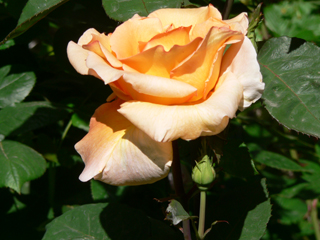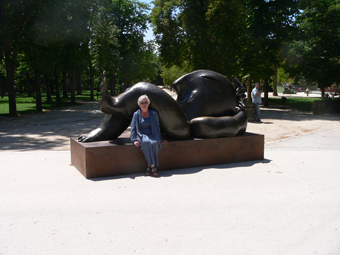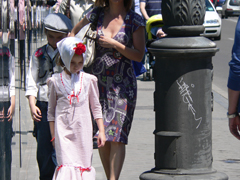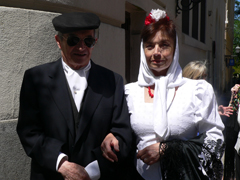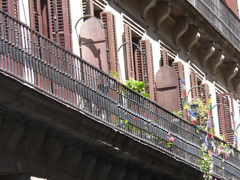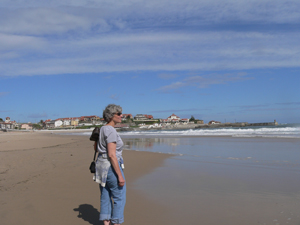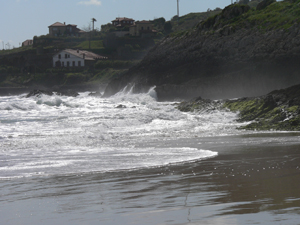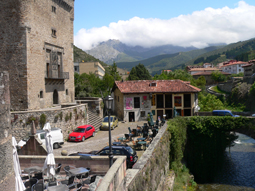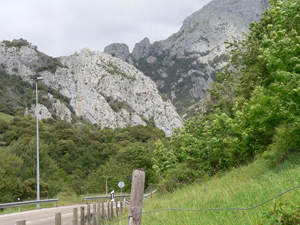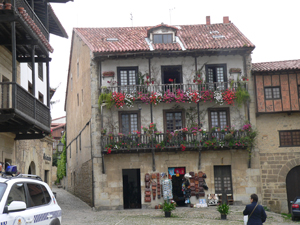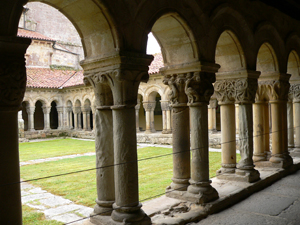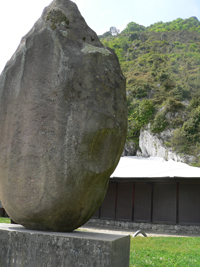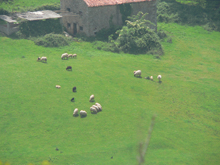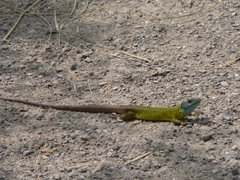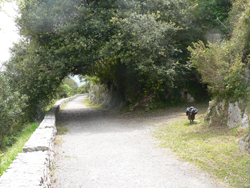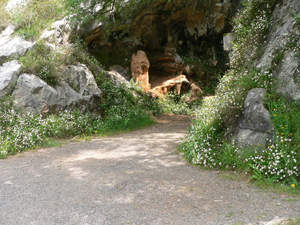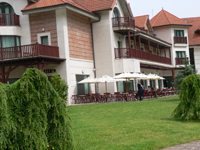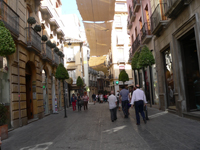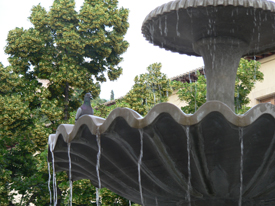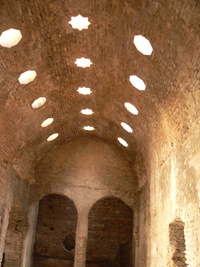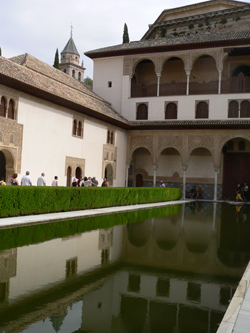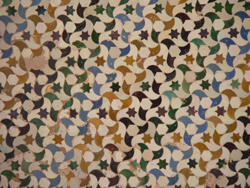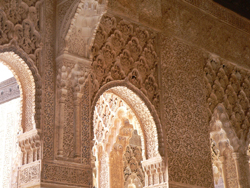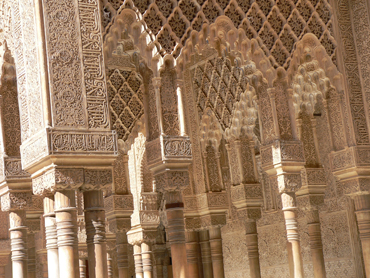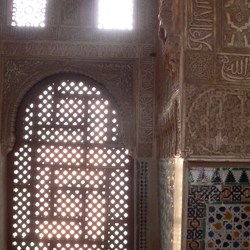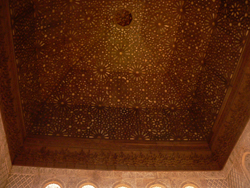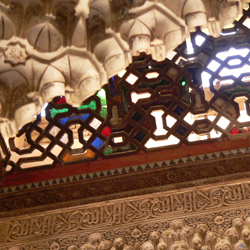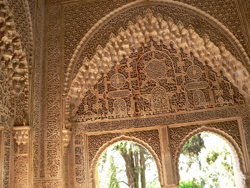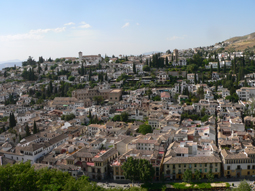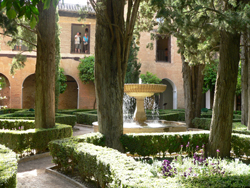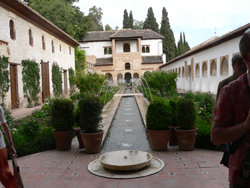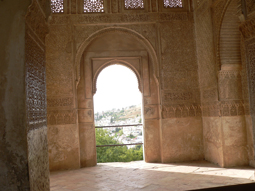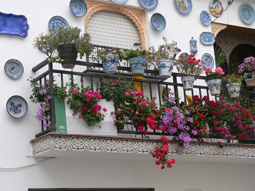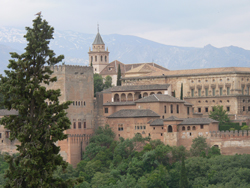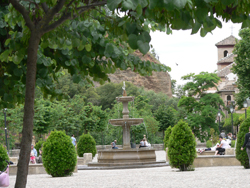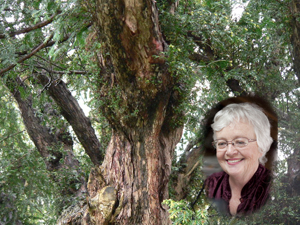

|
||||||||||||||||||||||||||||||||||||||||||||||||||
|
Spanish Notebook May 12 – 24, 2009 According to the National Geographic Genographic project and The Seven Daughters of Eve, a mitochondrial ancestor helped paint one of the caves in northern Spain some 12,000 years ago. So I had to see them. I could afford 12 days – with someone to share expenses. On May 12, my Loveland friend, Carol Radcliff, and I flew from Denver to Madrid (via Newark). We had two and a half days in Madrid where we toured three fabulous art museums (and saw one flamenco performance). The day we arrived we walked through the Museo Thyssen-Bornemisza witnessing the evolution of art from medieval to contemporary. It was fantastic to see how one artist tried something new then another took it further. We stopped for some iced tea in the museum’s lovely garden.
Next: the Prado, one of the world’s great art museums -- hundreds of (mostly Spanish) artists. I spent many pleasure-filled moments trying to decipher The Garden of Earthly Delights by Hieronymus Bosch. Goya’s El Dos de Mayo and El Tres de Mayo – so much larger and more powerful in person than reproductions – hammered my senses with the cruelty and stupidity of war. Behind the Prado, we wandered a portion of the 350 acre Parque Retiro. One area had some whimsical modern sculpture. That night, we explored Plaza Mayor and environs and found the “oldest restaurant in the world.” [Great sangria.] Friday, May 15, Madrid celebrated its Fiesta de San Isidro. Many people dressed up. Most attractions were closed. But always, balconies fringed every plaza and street. That night, we treated ourselves to a fabulous flamenco performance.
Saturday, we managed to tour Reina Sofia before catching the plane north. Sofia has Picasso’s Guernica, a work that had stunned me 40 years earlier when it was still in New York. It was just as powerful. Plus, several wonderfully bewildering works by Dali and Man Ray and other 20th century innovators. And then we flew north. The landscape got progressively greener as we approached the port city of Santander where we landed in a mist that hovered over the hills. We rented a car and drove to Comillas where the mist became a downpour. We found our inn, walked around Gaudy’s Capricho and the next morning walked the town’s beautiful beach. (Carol had agreed to go wherever I wanted as long as she could have a walk on the beach).
We made reservations for an afternoon tour of Tito Bustillo, our first cave. We drove to Ribadesella and (after turning around a few times) found the cave. There were five of us on the tour. We walked across a concrete bridge, through a green steel door in the side of the mountain, into a short tunnel that led to a chamber as tall and wide as my house. The natural colors of the rocks were shades of ochre, gold and pewter. Stalactites and stalagmites pierced the twilight space, lighted only by soft spotlights tucked into crevices. The floor was wet and slippery. The coolness, penetrating. We had walked a few yards when our guide stopped so we could hear a waterfall in a distant passage. Some stalactites had fused and could be played like a xylophone. There were successive narrow, sloping passages opening onto chambers. Rounding a corner, we would see a panel of paintings. Mostly horses – one just a charcoal outline sketched with double lines that gave it dimension. All but one faced south, toward the original cave entrance. Ancient peoples had used charcoal and iron oxide to create variations of red and black, often using the contours of the rock to echo forms. One horse was violet, colored with a rare mineral found only there and Lascaux, France. There were a few bison and reindeer. One chamber had paintings of the female body and vulvas. All of these were created between 22,000 and 10,000 years ago. From there, we drove to Santillana Del Mar, a perfectly preserved medieval village (oldest part – 1100s, more recent 1400s) where we were to stay in a parador (a government run historic home transformed into a hotel). There, we settled in and had a great dinner. Monday, all caves were closed (they are considered museums) so we drove into Picos de Europa (a national park) and the ancient (1400s) town of Potes. The surrounding mountains were gray-white, mostly limestone, which explains why there were/ are so many caves.
Tuesday, May 19, we were among the first to arrive at the Altamira museum. Inside, there was an exact replica of the cave that my ancient ancestor may have helped to paint. And the paintings – including an entire herd of bison – were magnificent. The museum also contained hundreds of exhibits, including mobile art like a tiny carved Venus from another cave. (I bought a reproduction.) I spent three hours taking notes.
The entrance to the museum and a view of the valley below. *** The rest of the day, we wandered Santillana, with its flowered balconies and serene cloister.
We obtained reservations for El Castillo cave. Wednesday we drove (eventually) to Puente Viesgo, arriving just in time for our tour. The cave had been occupied for more than 120,000 years; first by Neanderthals, then Homo Sapiens Sapiens. Our exuberant guide led four of us (Carol, me and a Spanish couple) into swirls of geological grandeur where six thousand (6,000) generations had left their marks. Some paintings were familiar mammals, some symbols and signs that have yet to be interpreted. Some primitive, some splendid.
When we left the time machine, we discovered it was possible to tour another cave, Monedas. We walked a long path around the mountain enjoying the valley below, the lizard and the ubiquitous flowers. We waited in quiet sunshine, joined by Lizzie from Whitby, England and then our guide, Helena – whose English barely contained her enthusiasm.
Moneda was an Upper Magdalene habitat, painted in my ancestor’s time. Again, the cave walls curved in all directions, again, narrow passages opened onto panels of buffalo, horses, deer – accurate and eternal. And mysterious symbols in red oxide. Helena described how mystical this cave must have been, lighted by marrow lamps flickering shadows among the shadows. It is still mystical. … We walked in silence back to our car and, eventually, found the (truly) Gran Hotel in Puento Viesgo where we had a scrumptious lunch (seafood ‘pudding’ [soufflé] and chocolate ice cream).
We arrived in Granada in time to check in and take the bus down the perpendicular hill to one plaza from which we walked to Plaza Nueva for a fine outdoor dinner. The Alhambra tour was not due to start until late the next afternoon so in the morning we returned to the central area, wandered among high-end shops, then bought too much from the low-end Marakesh Artinisas. Wandering the narrow street along the River Darro, we found the 11th century Muslim bathhouse, Banos Arabes El Baneulo, a cool, island of quiet next to the hot, crowded street.
And then: ALHAMBRA. Once a fortress, then complex of palaces under Moorish rule … then Christian … then abandoned and then restored. We were among the 7,000 that tour each day. I felt rushed. Every centimeter was a work of art. Too much to absorb … to photograph:
Water was used as mirrors or enchantment. Escher was inspired by the tile work.
The ceiling of the sultan’s receiving chamber was marquetry – 8700 pieces of cedar. Plaster carvings were once brilliantly colored. All the windows, stained glass. Only fragments remain.
Some windows overlooked Granada; some, peaceful courtyards. About a half-mile away, down a wide road through the ruins of staff quarters and other palaces, is the Generalife – the gardens and summer palace where the sultan and his retinue retreated from court business.
Saturday, May 23, we found our way to the Albayzin, Granada’s Moorish district, with its elegant courtyards and balconies. From the Mirador San Nicolas, we could see the Alhambra. Walking back to the city center, we were serenaded by wandering flute player as we passed through a lovely plaza. … Then we caught a plane to Madrid, where we stayed overnight before catching the plane to Newark and then the plane to Denver. And home.
From the beginning to the end of this incredible trip, we encountered art. Whether contemporary, medieval or prehistoric, art seems a primal instinct of our species. And I am grateful. - Mim Neal
|
||||||||||||||||||||||||||||||||||||||||||||||||||
